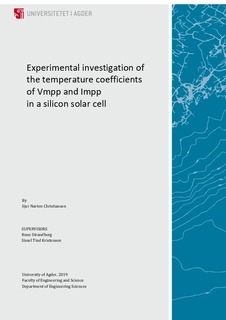| dc.contributor.author | Christiansen, Sjur Narten | |
| dc.date.accessioned | 2019-11-01T10:51:40Z | |
| dc.date.available | 2019-11-01T10:51:40Z | |
| dc.date.issued | 2018 | |
| dc.identifier.uri | http://hdl.handle.net/11250/2626075 | |
| dc.description | Master's thesis Renewable Energy ENE500 - University of Agder 2019 | nb_NO |
| dc.description.abstract | This thesis is meant to provide an experimental investigation of the temperature coefficient(b)of Vmpp compared to Voc in amulticrystallinesilicon solar cell.With the main question being: to what degree is the temperature coefficient equal for Voc and Vmpp and how does series losses(Rs)affect the two? Also investigating the same question for Isc and Impp. Three types of multicrystalline cells have been measured using a NeonSee AAA sun simulator, for a total of 18 tested cells all produced by Elkem SolarSilicon. I-V data wascollected using temperature scan, Suns-Voc and Isc-Voc measurements, with temperatures reflecting normal operation range for solar cells, from 25 to 65°C. The different cells tested have been Al-BSF, PERC 0.5 and PERC 1.3 cells. Theresultingdata hasbeen calculated using Excel providingbresults for Voc, Vmpp, Isc and Impp. For all bresults, standard deviation of slope was also calculated to say something about the accuracy of the measurements.Results from theanalysed data show a trend where bVoc is statistically significant different from bVmpp. This is concluded based on the results where the majority cells tested show bVoc having a larger value than bVmpp, without any overlapping instandard deviation. The degree of differencevaries with the different cells and the different measuring techniques. As for the effect of Rs, the difference in results between the Tscan measuring technique and the Suns-Voc and Isc-Voc techniques have been analysed. A trend of lower values for bVmppfrom Tscan measurements indicates that Rs has a negative effect on the bVmpp. Generally, the results show that bfor current is more varyingthan for voltage data. Results compared between the different measuring techniques are showing less visible trends for bIsc and bImpp than for bVocand bVmpp. There are less systematic differences between Tscan data and the two other methods. This is probably because Rs should have little or no effect on the current.For most of the cells calculated, standard deviation is very low for both current and voltage calculations, which is a sign that the measurements are accurate, however more testing is requiredto statemore conclusive evidence. | nb_NO |
| dc.language.iso | eng | nb_NO |
| dc.publisher | Universitetet i Agder ; University of Agder | nb_NO |
| dc.rights | Attribution-NonCommercial-NoDerivatives 4.0 Internasjonal | * |
| dc.rights.uri | http://creativecommons.org/licenses/by-nc-nd/4.0/deed.no | * |
| dc.subject | ENE500 | nb_NO |
| dc.title | Experimental investigation of the temperature coefficients of Vmpp and Impp in a silicon solar cell | nb_NO |
| dc.type | Master thesis | nb_NO |
| dc.subject.nsi | VDP::Teknologi: 500::Elektrotekniske fag: 540 | nb_NO |
| dc.source.pagenumber | 47 p. | nb_NO |

